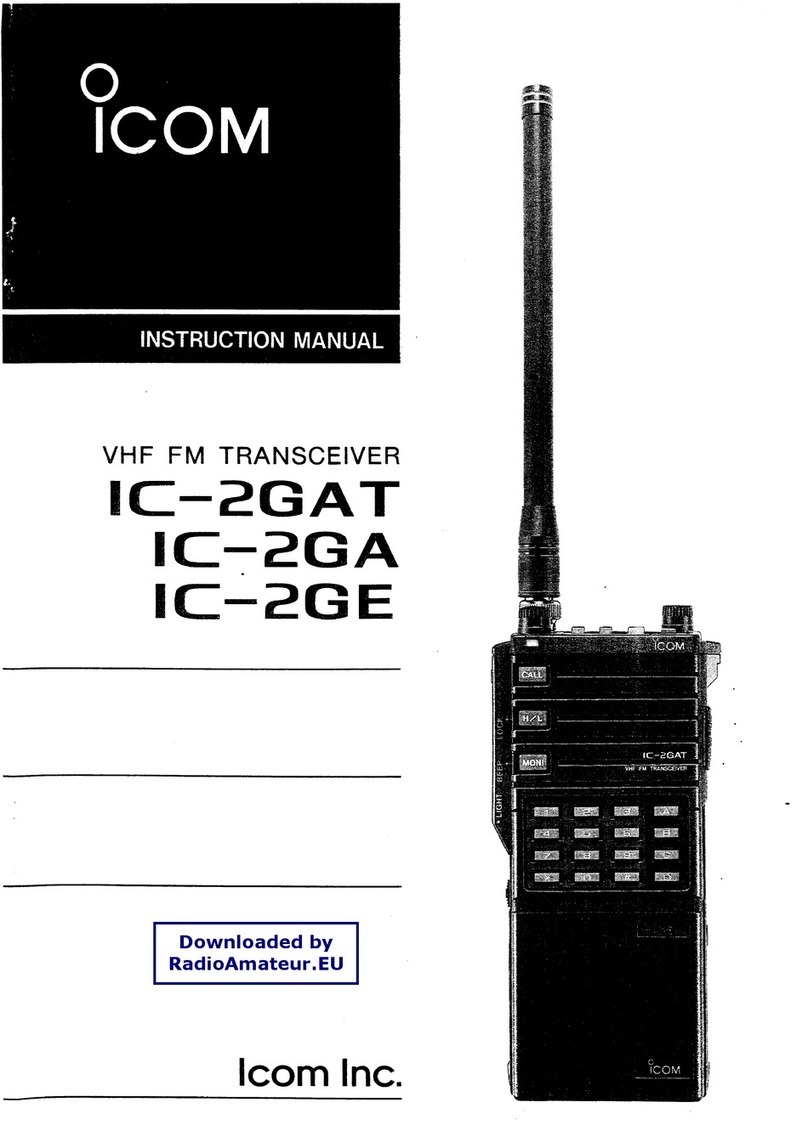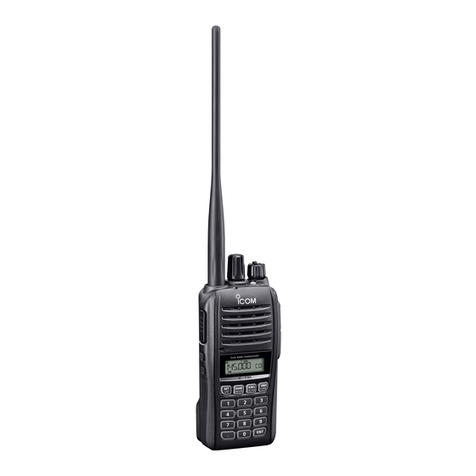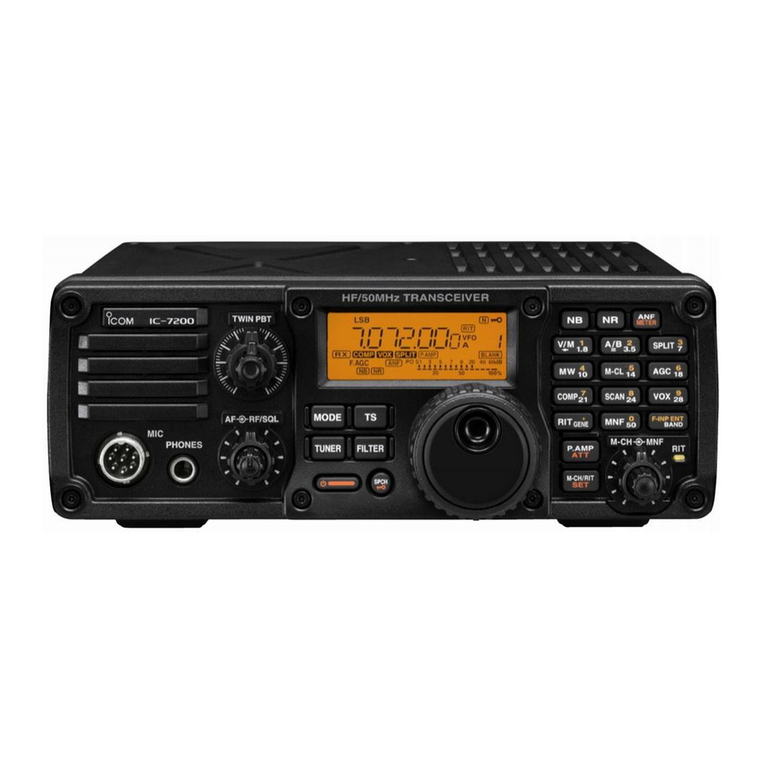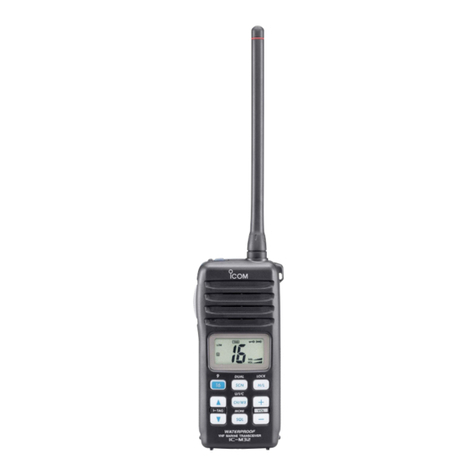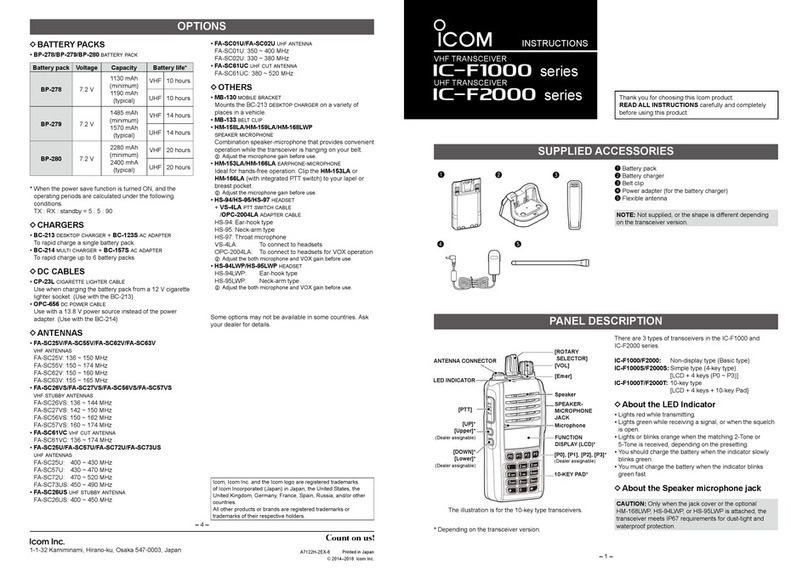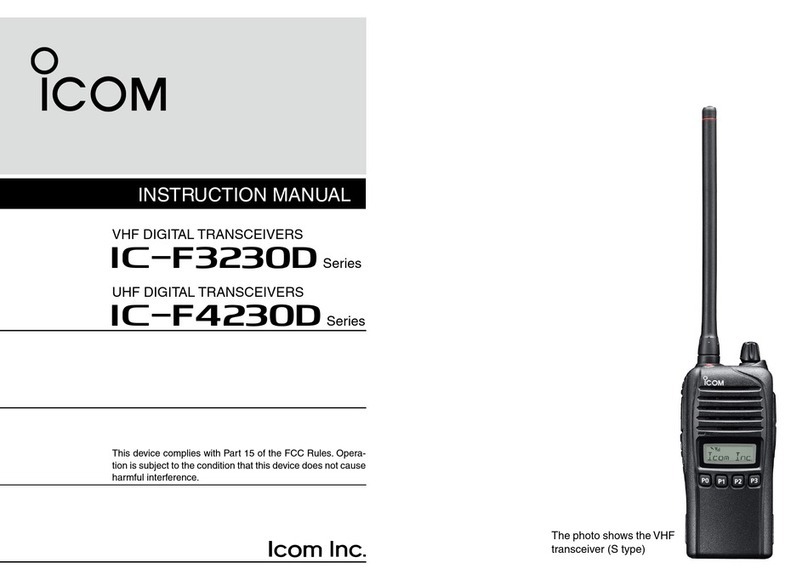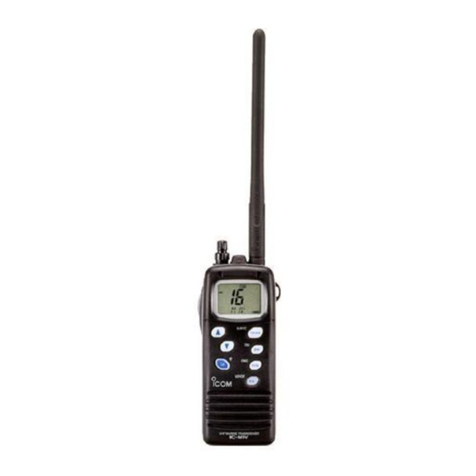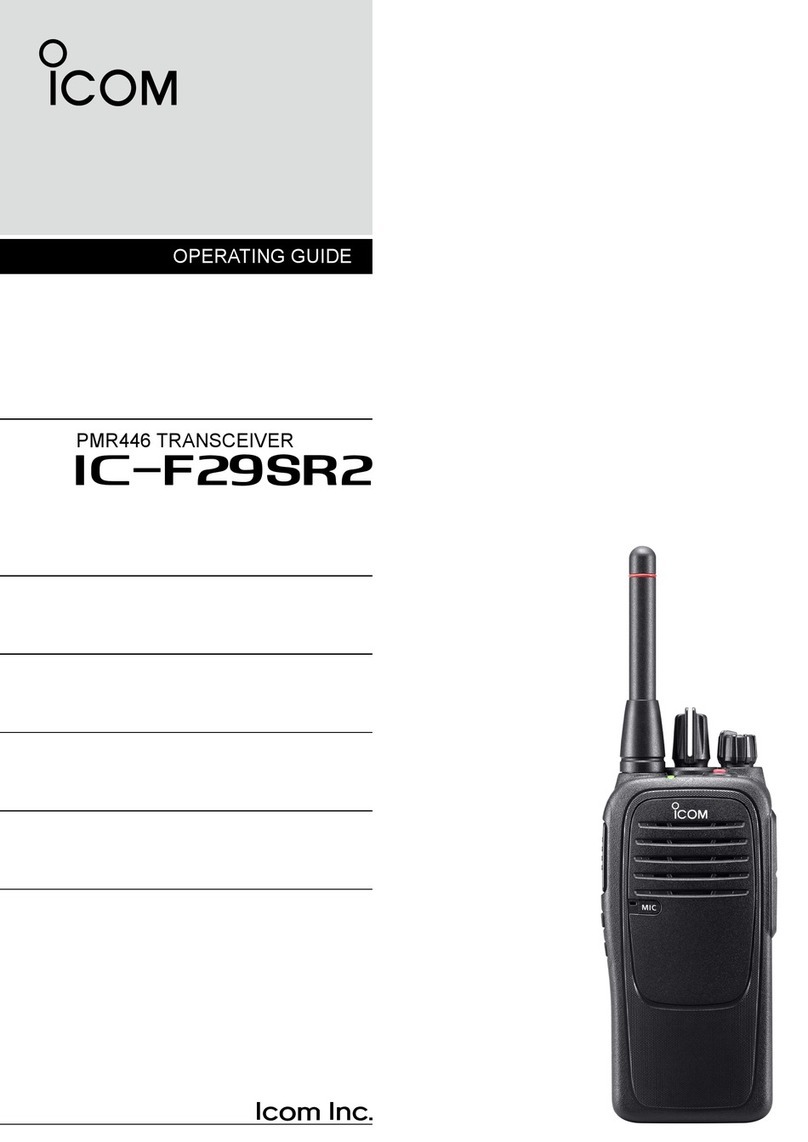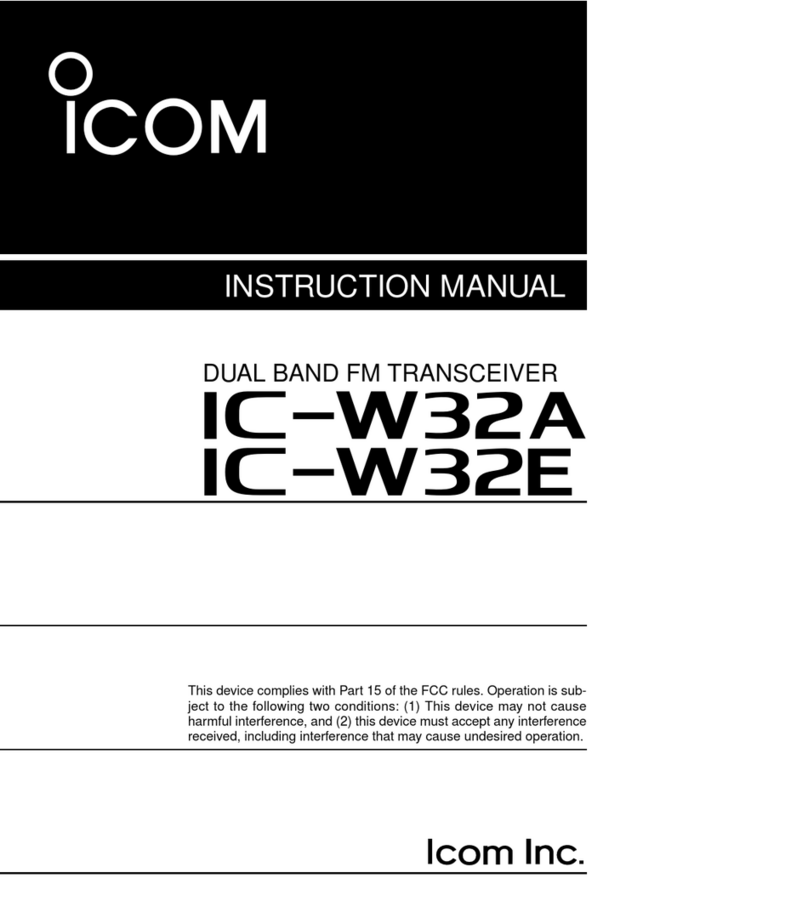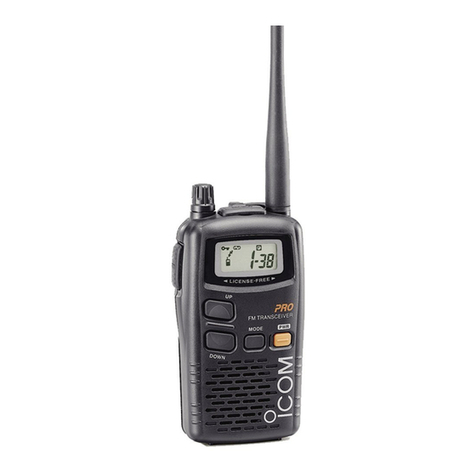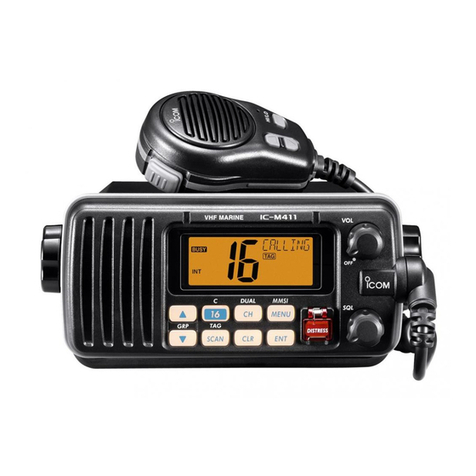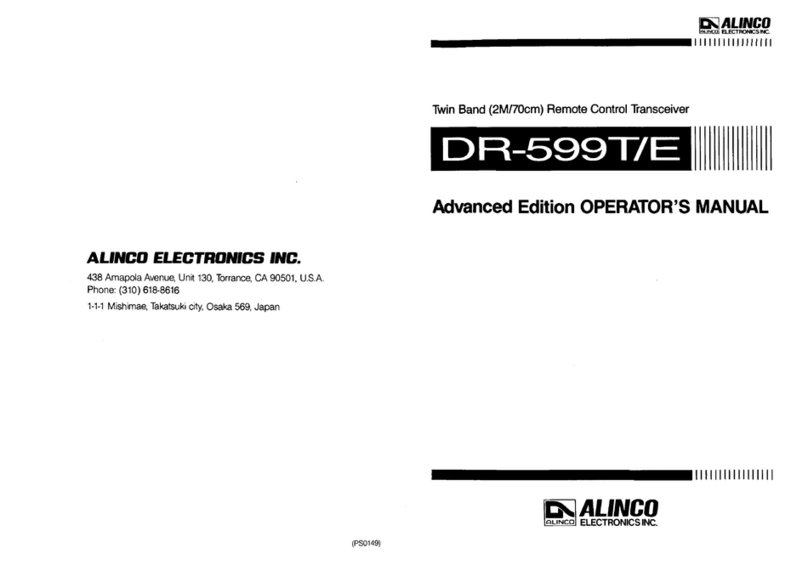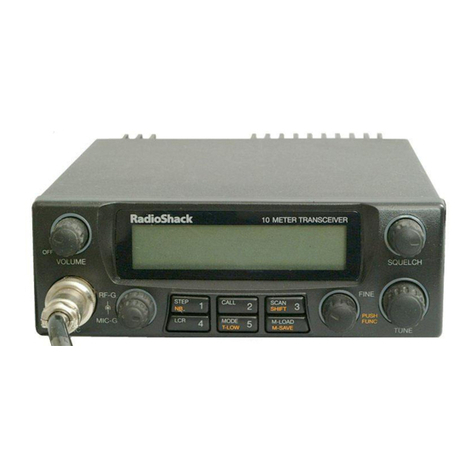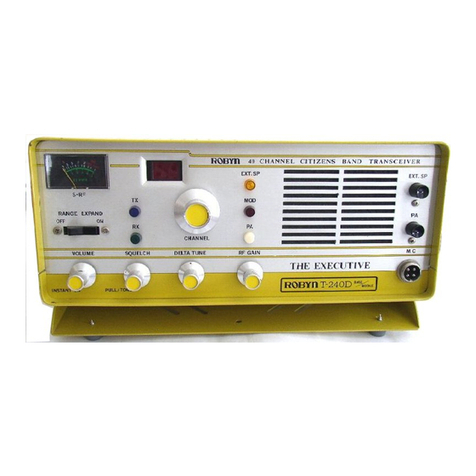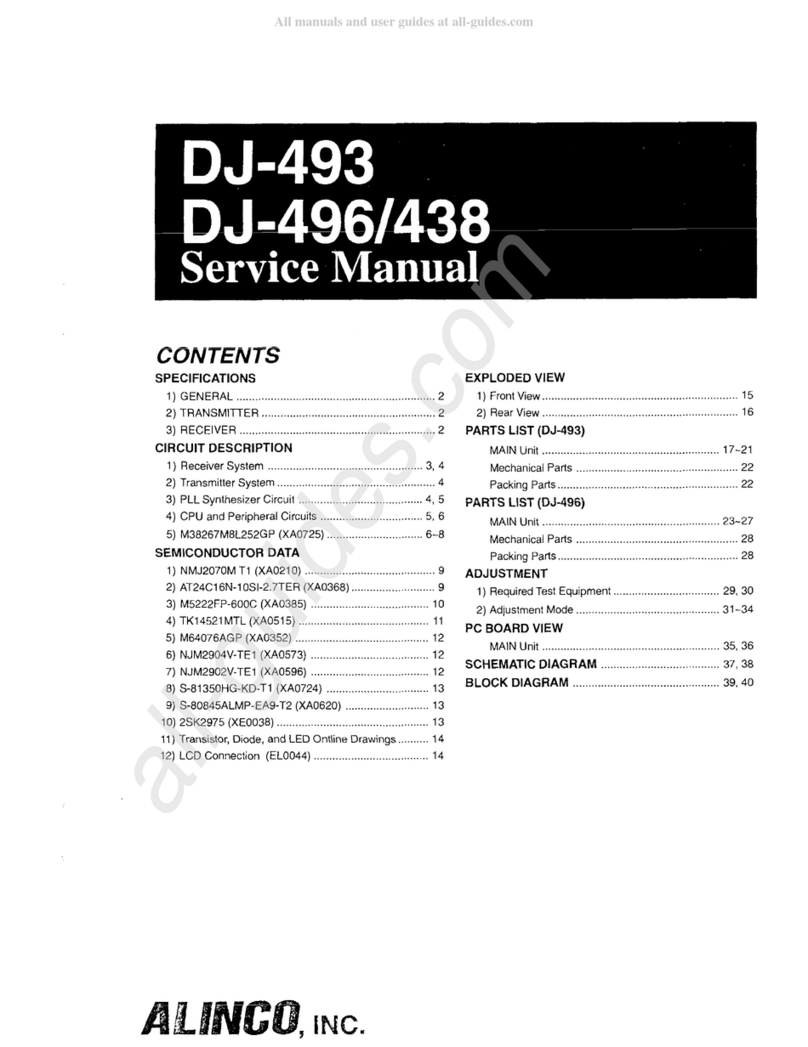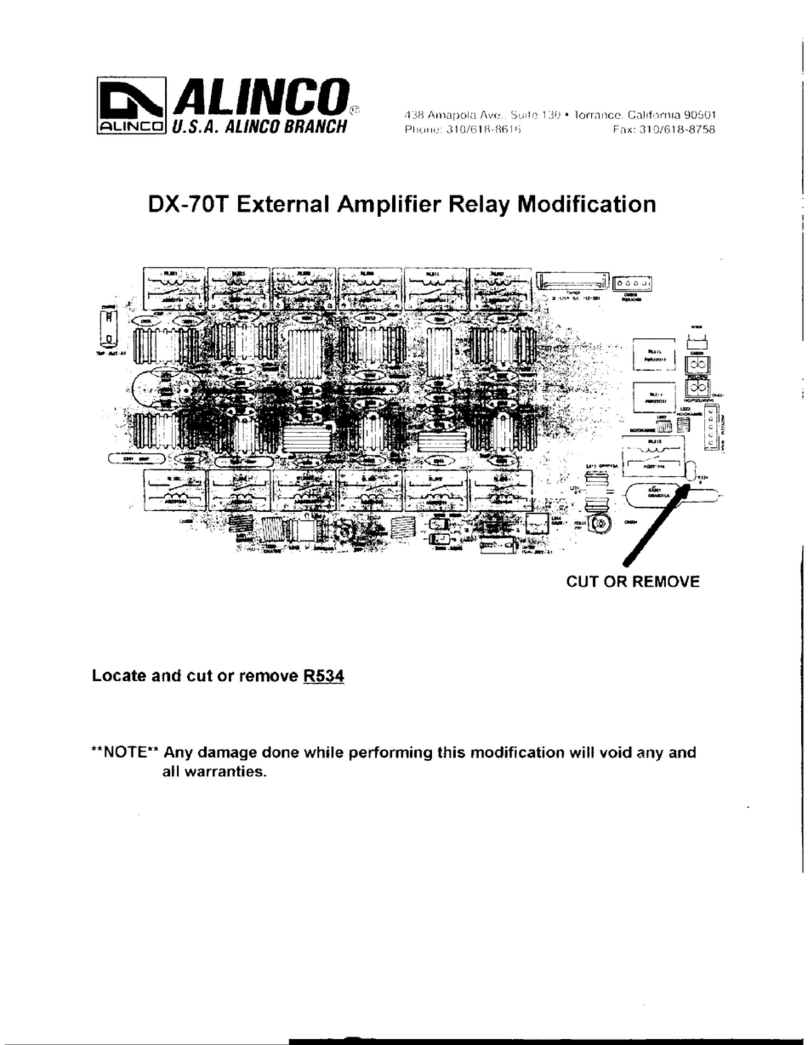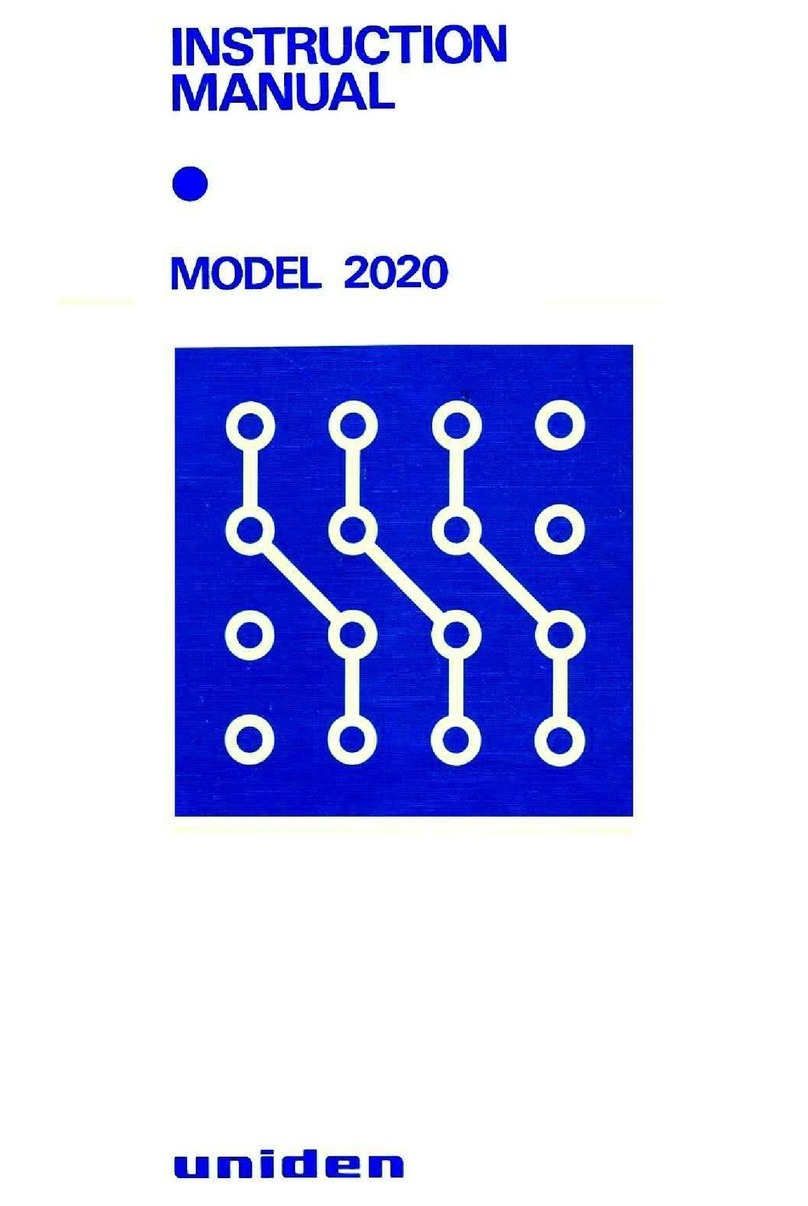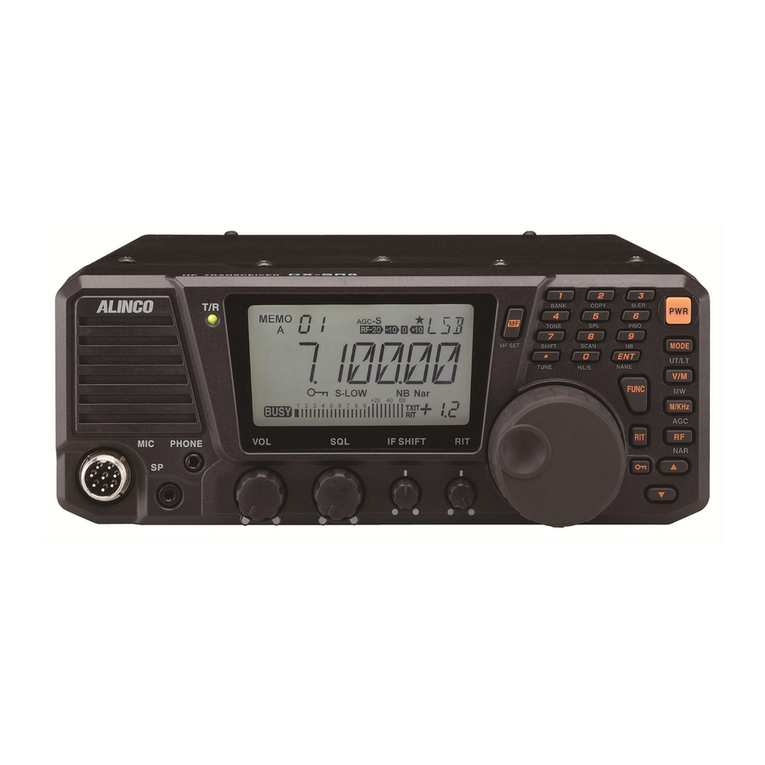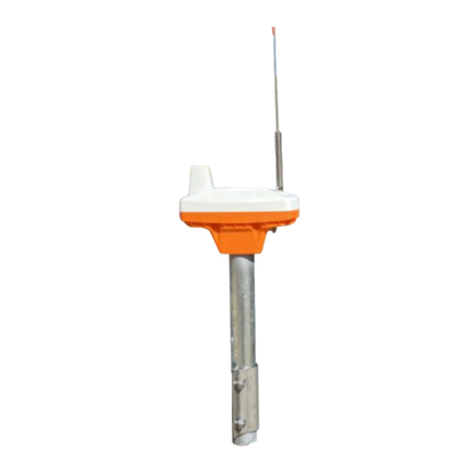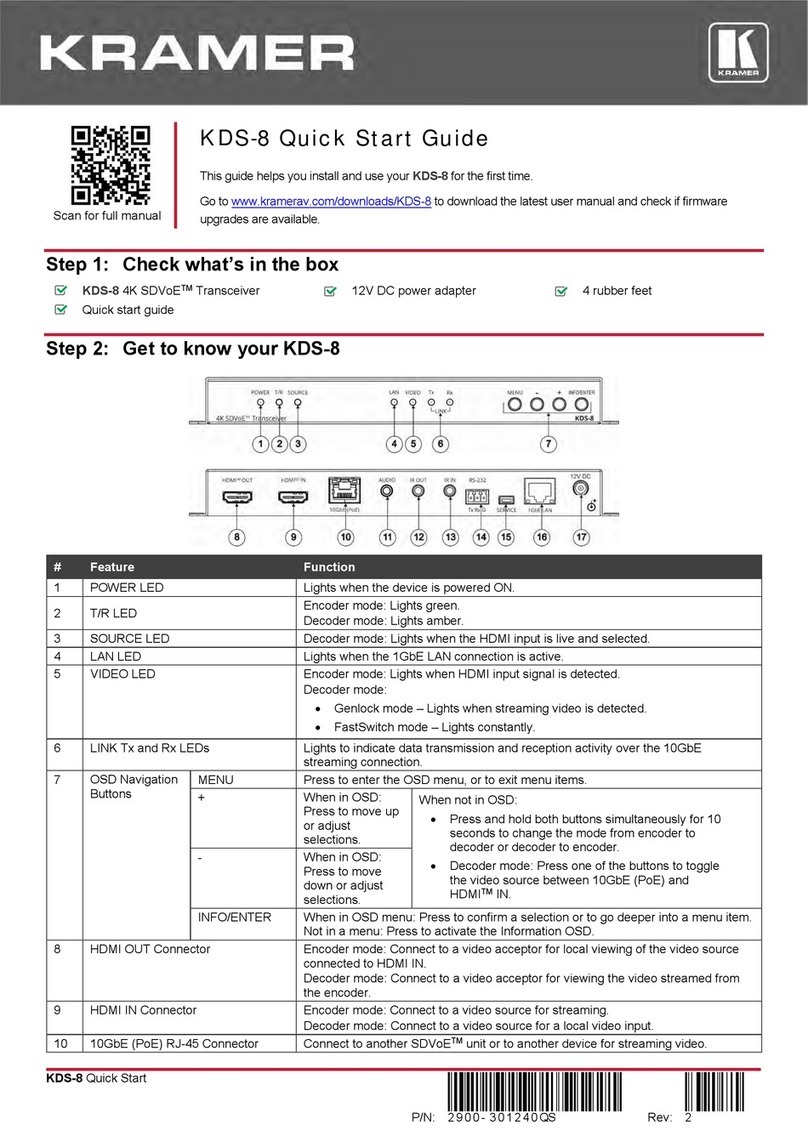Icom IC-M73 User manual

INSTRUCTION MANUAL
iM73
VHF MARINE TRANSCEIVER
This device complies with Part 15 of the FCC Rules. Opera-
tion is subject to the condition that this device does not cause
harmful interference.
iM73EURO
INSTRUCTION MANUAL
This device complies with Part 15 of the FCC Rules. Opera-
tion is subject to the condition that this device does not cause
iM73EURO
IC-M73 IC-M73EURO

i
New2001
FOREWORD
Thank you for purchasing this Icom product. The IC-M73/IC-
M73EURO v h f m a r i n e t r a n s c e i v e r is designed and built
with Icom’s state of the art technology and craftsmanship.
With proper care, this product should provide you with years
of trouble-free operation.
IMPORTANT
READ ALL INSTRUCTIONS carefully and completely
before using the transceiver.
SAVE THIS INSTRUCTION MANUAL — This in-
struction manual contains important operating instructions
for the IC-M73/IC-M73EURO.
EXPLICIT DEFINITIONS
WORD DEFINITION
RDANGER! Personal death, serious injury or an ex-
plosion may occur.
RWARNING! Personal injury, fire hazard or electric
shock may occur.
CAUTION Equipment damage may occur.
NOTE If disregarded, inconvenience only.No risk
of personal injury, fire or electric shock.
FEATURES
☞Submersible construction
Built tough to withstand the punishing marine environ-
ment, the IC-M73/IC-M73EURO’s submersible construc-
tion meets IPX8 ratings of the International Standard IEC
60529 (2001).
In addition, the speaker grill structure with a water self-
draining Aquaquake function is helpful for easily removing
rain or seawater.
☞Dualwatch and Tri-watch functions
Convenient functions that allow you to monitor the distress
channel (Ch 16) while receiving one other channel of your
choice (Dualwatch), or while receiving one other channel
of your choice and the Call channel (Tri-watch*). See page
16 for details.
* May not be available depending on the transceiver version.
☞Voice recorder function
IC-M73/IC-M73EURO has a voice recorder function* which
can automatically, or manually, record the received signal.
The automatic (60 seconds) and manual (30 seconds) re-
cordings are recorded separately into memory in the trans-
ceiver.
* May not be available depending on the transceiver version.
☞Bass booster function
The TX/RX bass booster functions* boosts the frequen-
cies to increase the bass level, if desired.
* May not be available depending on the transceiver version.

ii
New2001
RDANGER! NEVER short the terminals of the battery
pack.
RDANGER! Use and charge only specified Icom battery
packs with Icom radios or Icom chargers.Only Icom battery packs
are tested and approved for use with Icom radios or charged with
Icom chargers. Using third-party or counterfeit battery packs or
chargers may cause smoke, fire, or cause the battery to burst.
RWARNING! NEVER connect the transceiver to an AC
outlet. This may pose a fire hazard or result in an electric shock.
RWARNING! NEVER hold the transceiver so that the an-
tenna is closer than 2.5 cm (1 inch) from exposed parts of the
body, especially the face or eyes, while transmitting. The trans-
ceiver will perform best if the microphone is 5 to 10 cm (2 to 4
inches) away from the lips and the transceiver is vertical.
CAUTION: NEVER connect the transceiver to a power
source other than the products specified by Icom. Such a connec-
tion will ruin the transceiver.
CAUTION: MAKE SURE the flexible antenna and bat-
tery pack are securely attached to the transceiver, and that the
antenna and battery pack are dry before attachment. Exposing
the inside of the transceiver to water will result in serious damage
to the transceiver.
BE CAREFUL! The transceiver meets IPX8 requirements
for waterproof protection. However, once the transceiver has
been dropped, waterproof protection cannot be guaranteed be-
cause of possible damage to the transceiver's case or the water-
proof seal.
DO NOT use or place the transceiver in direct sunlight or in
areas with temperatures below –20°C (–4°F) or above +60°C
(+140°F) for the EXP/USA versions, below –15°C (+5°F) or
above +55°C (+131°F) for the CHN/EUR/FRG/HOL/UK versions,
and below –10°C (+14°F) or above +55°C (+131°F) for the AUS
versions.
DO NOT use harsh solvents such as benzine or alcohol when
cleaning, as they will damage the transceiver surfaces.
DO NOT push [PTT] when not actually intending to transmit.
DO NOT modify the transceiver.The transceiver warranty does
not cover any problems caused by unauthorized modification.
DO NOT operate the transceiver near unshielded electrical
blasting caps or in an explosive atmosphere.
KEEP the transceiver out of the reach of children.
KEEP the transceiver at least 0.9 meter (3.0 feet) away from
your vessel’s magnetic navigation compass.
PRECAUTIONS
Icom, Icom Inc. and the Icom logo are registered trademarks of Icom
Incorporated (Japan) in Japan, the United States, the United Kingdom,
Germany, France, Spain, Russia and/or other countries.

iii
RADIO OPERATOR WARNING
WARNING
Icom requires the radio operator to meet the
FCC and IC Requirements for Radio Frequency
Exposure. An omnidirectional antenna with gain
not greater than 9 dBi must be mounted a mini-
mum of 5 meters (measured from the lowest
point of the antenna) vertically above the main
deck and all possible personnel. This is the minimum safe
separation distance estimated to meet all RF exposure com-
pliance requirements. This 5 meter distance is based on the
FCC and IC Safe Maximum Permissible Exposure (MPE) dis-
tance of 3 meters added to the height of an adult (2 meters)
and is appropriate for all vessels.
For watercraft without suitable structures, the antenna must
be mounted so as to maintain a minimum of 1 meter vertically
between the antenna, (measured from the lowest point of the
antenna), to the heads of all persons AND all persons must
stay outside of the 3 meter MPE radius.
Do not transmit with radio and antenna when persons are
within the MPE radius of the antenna, unless such persons
(such as driver or radio operator) are shielded from antenna
field by a grounded metallic barrier. The MPE Radius is the
minimum distance from the antenna axis that person should
maintain in order to avoid RF exposure higher than the allow-
able MPE level set by FCC and IC.
FAILURE TO OBSERVE THESE LIMITS MAY ALLOW
THOSE WITHIN THE MPE RADIUS TO EXPERIENCE RF
RADIATION ABSORPTION WHICH EXCEEDS THE MAXI-
MUM PERMISSIBLE EXPOSURE (MPE) LIMIT.
IT IS THE RESPONSIBILITY OF THE RADIO OPERATOR
TO ENSURE THAT THE MAXIMUM PERMISSIBLE EXPO-
SURE LIMITS ARE OBSERVED AT ALL TIMES DURING
RADIO TRANSMISSION. THE RADIO OPERATOR IS TO
ENSURE THAT NO BYSTANDERS COME WITHIN THE
RADIUS OF THE MAXIMUM PERMISSIBLE EXPOSURE
LIMITS.
Determining MPE Radius
THE MAXIMUM PERMISSIBLE EXPOSURE (MPE) RADIUS
HAS BEEN ESTIMATED TO BE A RADIUS OF ABOUT 3M
PER OET BULLETIN 65 OF THE FCC.
THIS ESTIMATE IS MADE ASSUMING THE MAXIMUM
POWER OF THE RADIO AND ANTENNAS WITH A MAXI-
MUM GAIN OF 9dBi ARE USED FOR A SHIP MOUNTED
SYSTEM.

iv
AVERTISSEMENT POUR LES OPÉRATEURS RADIO
Icom exige que l'opérateur radio se conforme
aux exigences de la FCC et d’IC en matière
d'exposition aux radiofréquences. Une antenne
omnidirectionnelle dont le gain ne dépasse pas
9dBi doit être fixée à une distance minimale de
5 mètres (mesurée depuis le point le plus bas
de l'antenne) verticalement au-dessus du pont principal et de tout
le personnel qui peut s'y trouver. Il s'agit de la distance de sécurité
minimale prévue pour satisfaire aux exigences de conformité en mat-
ière d'exposition aux RF. Cette distance de 5 mètres est établie en
fonction de l'exposition maximale admissible sécuritaire de 3 mètres
établie par la FCC et d’IC, à laquelle on ajoute la hauteur d'un adulte
(2 mètres); cette distance convient pour tous les navires.
Dans le cas des embarcations sans structure convenable, l'antenne
doit être fixée de façon à maintenir une distance minimale de 1 mètre
verticalement entre cette antenne (mesurée depuis son point le plus
bas) et la tête de toute personne présente; toutes les personnes
présentes doivent se tenir à l'extérieur d'un rayon d'exposition maxi-
male admissible de 3 mètres.
Ne pas émettre à l'aide de la radio et de l'antenne lorsque des
personnes se trouvent à l'intérieur du rayon d'exposition maximale
admissible de cette antenne, à moins que ces personnes (comme
le conducteur ou l'opérateur radio) ne soient protégées du champ
de l'antenne par un écran métallique relié à la masse. Le rayon
d'exposition maximale admissible équivaut à la distance minimale
que cette personne doit maintenir entre elle et l'axe de l'antenne pour
éviter une exposition aux RF supérieure au niveau d'exposition maxi-
male admissible fixé par la FCC et d’IC.
LE NON-RESPECT DE CES LIMITES PEUT CAUSER, POUR LES
PERSONNES SITUÉES DANS LE RAYON D'EXPOSITION MAXI-
MALE ADMISSIBLE, UNE ABSORPTION DE RAYONNEMENT DE
RF SUPÉRIEURE À L'EXPOSITION MAXIMALE ADMISSIBLE
FIXÉE.
L'OPÉRATEUR RADIO EST RESPONSABLE D'ASSURER QUE
LES LIMITES D'EXPOSITION MAXIMALE ADMISSIBLE SOIENT
RESPECTÉES EN TOUT TEMPS PENDANT LA TRANSMISSION
RADIO. L'OPÉRATEUR RADIO DOIT S'ASSURER QU'AUCUNE
PERSONNE PRÉSENTE NE SE SITUE À L'INTÉRIEUR DU RAY-
ON D'EXPOSITION MAXIMALE ADMISSIBLE.
Établir le rayon d'exposition maximale admissible
ON ESTIME QUE LE RAYON D'EXPOSITION MAXIMALE ADMIS-
SIBLE EST D'ENVIRON 3 M, TEL QUE STIPULÉ DANS LE BUL-
LETIN OET 65 DE LA FCC. CETTE DISTANCE ESTIMÉE TIENT
COMPTE D'UN SYSTÈME INSTALLÉ SUR UN NAVIRE UTILISANT
LA PUISSANCE MAXIMALE DE LA RADIO ET DES ANTENNES
DONT LE GAIN MAXIMAL EST DE 9dBi.
AVERTISSEMENT

v
COUNTRY CODE LIST
• ISO 3166-1
Country Codes Country Codes
1
2
3
4
5
6
7
8
9
10
11
12
13
14
15
16
17
Austria
Belgium
Bulgaria
Croatia
Czech Republic
Cyprus
Denmark
Estonia
Finland
France
Germany
Greece
Hungary
Iceland
Ireland
Italy
Latvia
AT
BE
BG
HR
CZ
CY
DK
EE
FI
FR
DE
GR
HU
IS
IE
IT
LV
18
19
20
21
22
23
24
25
26
27
28
29
30
31
32
33
Liechtenstein
Lithuania
Luxembourg
Malta
Netherlands
Norway
Poland
Portugal
Romania
Slovakia
Slovenia
Spain
Sweden
Switzerland
Turkey
United Kingdom
LI
LT
LU
MT
NL
NO
PL
PT
RO
SK
SI
ES
SE
CH
TR
GB
FOR CLASS A UNINTENTIONAL RADIATORS
This equipment has been tested and found to comply with the
limits for a Class A digital device, pursuant to part 15 of the
FCC Rules. These limits are designed to provide reasonable
protection against harmful interference when the equipment
is operated in a commercial environment. This equipment
generates, uses, and can radiate radio frequency energy
and, if not installed and used in accordance with the instruc-
tion manual, may cause harmful interference to radio commu-
nications. Operation of this equipment in a residential area is
likely to cause harmful interference in which case the user will
be required to correct the interference at his own expense.
CAUTION: Changes or modifications to this device, not ex-
pressly approved by Icom Inc., could void your authority to
operate this device under FCC regulations.
FCC INFORMATION

vi
New2001
IN CASE OF EMERGENCY
If your vessel requires assistance, contact other vessels and
the Coast Guard by sending a distress call on Channel 16.
❍ USING CHANNEL 16
DISTRESS CALL PROCEDURE
1. “MAYDAY MAYDAY MAYDAY.”
2. “THIS IS ...........................” (name of vessel)
3. Say your call sign or other indication of the
vessel.
4. “LOCATED AT ..................... ” (your position)
5.State the nature of the distress and
assistance required.
6. Give any other information which might
facilitate the rescue.
RECOMMENDATION
CLEAN THE TRANSCEIVER THOROUGHLY WITH FRESH
WATER after exposure to saltwater, and dry it before opera-
tion. Otherwise, the transceiver’s keys, switches and control-
lers may become inoperable due to salt crystallization.
NOTE: DO NOT wash the transceiver in water if there is any
reason to suspect the waterproofing may not be effective.
For example, in cases where the transceiver/battery pack is
cracked or broken, or has been dropped, or when the battery
pack is detached from the transceiver.

New2001
vii
New2001
TABLE OF CONTENTS
FOREWORD ..................................................................................... i
IMPORTANT...................................................................................... i
EXPLICIT DEFINITIONS................................................................... i
FEATURES........................................................................................ i
PRECAUTIONS................................................................................ ii
RADIO OPERATOR WARNING ...................................................... iii
AVERTISSEMENT POUR LES OPÉRATEURS RADIO.................. iv
FCC INFORMATION ........................................................................ v
COUNTRY CODE LIST.................................................................... v
IN CASE OF EMERGENCY............................................................ vi
RECOMMENDATION ...................................................................... vi
TABLE OF CONTENTS.................................................................. vii
1 OPERATING RULES ..................................................................1
2 SUPPLIED ACCESSORIES AND ATTACHMENTS...............2–3
■ Supplied accessories...............................................................2
■ Attachments.............................................................................2
3 PANEL DESCRIPTION ...........................................................4–7
■ Front, top and side panels .......................................................4
■ Function display.......................................................................6
4 BASIC OPERATION .............................................................8–13
■ Channel selection ....................................................................8
■ Receiving and transmitting ....................................................11
■ Call channel programming.....................................................12
■ Lock function..........................................................................12
■ Monitor function .....................................................................12
■ Adjusting the squelch level ....................................................13
■ AquaQuake water draining function.......................................13
5 SCAN OPERATION (Except for the Dutch version)............14–15
■ Scan types.............................................................................14
■ Setting Favorite channels ......................................................15
■ Starting a scan.......................................................................15
6 DUALWATCH/TRI-WATCH .......................................................16
■ Description.............................................................................16
■ Operation...............................................................................16
7 FUNCTION MODE OPERATION ........................................17–24
■ About the function mode........................................................17
■ Manual recording function (Depending on versions) .............18
■
Automatic recording function (Depending on versions)
.............19
■ Play back function (Depending on versions)..........................20
■ Channel naming function.......................................................21
■ Opening comment entry function...........................................22
■ ATIS code programming
(For only the Dutch and German versions)
............................ 23
■ Backlight function...................................................................24
8 SET MODE..........................................................................25–30
■ SET mode programming........................................................25
■ SET mode items ....................................................................26
9 BATTERY CHARGING .......................................................31–34
■ Battery cautions.....................................................................31
■ Supplied battery charger .......................................................33
■ Optional battery chargers ......................................................34
10 OPTIONAL SWIVEL BELT CLIP..............................................35
■ Attaching................................................................................35
■ Detaching...............................................................................35
11 OPTIONAL SPEAKER-MICROPHONE....................................36
■ HM-167 descriptions..............................................................36
■ Attaching................................................................................36
12 TROUBLESHOOTING ..............................................................37
13 SPECIFICATIONS...............................................................38–39
14 VHF MARINE CHANNEL LIST...........................................40–42
15 OPTIONS ..................................................................................43
INDEX.......................................................................................44–45

1
1
OPERATING RULES
New2001
1
2
3
4
5
6
7
8
9
10
11
12
13
14
15
16
DPriorities
• Read all rules and regulations pertaining to call priorities,
and keep an up-to-date copy handy. Safety and distress
calls take priority over all others.
• You must monitor Channel 16 when you are not operating
on another channel.
• False or fraudulent distress calls are prohibited under law.
DPrivacy
• Information overheard, but not intended for you, cannot law-
fully be used in any way.
• Indecent or profane language is prohibited.
DRadio licenses
(1) SHIP STATION LICENSE
You may require a current radio station license before using
the transceiver. It is unlawful to operate a ship station which is
not licensed, but required to be.
If required, contact your dealer or the appropriate govern-
ment agency for a Ship-Radiotelephone license application.
This government-issued license states the call sign which is
your craft’s identification for radio purposes.
(2) OPERATOR’S LICENSE
A Restricted Radiotelephone Operator Permit is the license
most often held by small vessel radio operators when a radio
is not required for safety purposes.
If required, the Restricted Radiotelephone Operator Permit
must be posted or kept with the operator. If required, only a
licensed radio operator may operate a transceiver.
However, non-licensed individuals may talk over a transceiver
if a licensed operator starts, supervises, ends the call and
makes the necessary log entries.
A current copy of the applicable government rules and regu-
lations is only required to be on hand for vessels in which
a radio telephone is compulsory. However, even if you are
not required to have these on hand it is your responsibility to
be thoroughly acquainted with all pertinent rules and regula-
tions.
NOTE: Even though the transceiver is capable of opera-
tion on VHF marine channels 3, 21, 23, 61, 64, 81, 82 and
83, according to FCC regulations these simplex channels
cannot be lawfully used by the general population in USA
waters.

New2001
2
New2001
SUPPLIED ACCESSORIES AND ATTACHMENTS
2
■Supplied accessories ■Attachments
DFlexible antenna
Connect the supplied flexible
antenna to the antenna connector.
CAUTION:
• NEVER carry the transceiver
by holding the antenna.
• Transmitting without an antenna
may damage the transceiver.
DHandstrap
Pass the handstrap through the
loop on the top corner of the
transceiver, as illustrated to the
left. This facilitates carrying the
transceiver.
Flexible antenna
Cigarette lighter cable
Handstrap
(Not supplied or different type
may be supplied depending
on the version)
(May not be supplied,
depending on the version)
Battery Charger
(with two screws)
Belt clip
(with two screws)
Li-ion battery pack
AC adapter

New2001
3
2
SUPPLIED ACCESSORIES AND ATTACHMENTS
New2001
1
2
3
4
5
6
7
8
9
10
11
12
13
14
15
16
DBattery pack
Attach the battery pack into the transceiver.q
Battery pack
Lock the battery pack with the latch.w
Latch
CAUTION:
NEVER remove or attach the battery pack when the trans-
ceiver is wet or soiled. This may result in water or dust get-
ting into the transceiver and battery pack, and may result
in them being damaged.
Be careful! The latch is tightly locked, so use caution when
releasing it. DO NOT use your finger nail. Use the edge of
a coin or screwdriver tip to carefully release it.
DBelt clip
Attach the belt clip to the transceiver.
Supplied screws

New2001
4
New2001
PANEL DESCRIPTION
3
■Front, top and side panels
q
w
e
y
t
r
Microphone
!2
!1
!0
o
u
i
Speaker
Function
display (p. 6)
qVOLUME CONTROL [VOL]
Turns ON power and adjusts the audio level.
wPTT SWITCH [PTT]
Hold down to transmit; release to receive.
e MONITOR KEY []
• Manually opens the squelch to monitor the channel while
held down. (p. 12)
• Push this switch, then adjust the squelch level with [Y]/
[Z]. (p. 13)
• While holding down this switch, turn the ON power to
enter the SET mode. (p. 25)
rCHANNEL 16 KEY [16/C]
• Selects Channel 16 when pushed. (p. 8)
•
Selects the Call channel when pushed for 1 second.
(p. 8)
•
Enters the Call channel write mode when the Call channel
is selected and this key is held down for 3 seconds. (p. 12)
tFUNCTION KEY [F]
• Enters the Function mode when pushed. (p. 17)
• The AquaQuake function is activated when held down for
1 second. (p. 13)
• While holding down this key, turn ON the power to enter
the recording counter mode.

New2001
5
3
PANEL DESCRIPTION
New2001
1
2
3
4
5
6
7
8
9
10
11
12
13
14
15
16
ySCAN KEY [SCAN•DUAL]
• Starts and stops normal or priority scan when pushed.
(pp. 14, 15)
• Enters the Watch mode when held down for 1 second.
(p. 16)
uCHANNEL/WEATHER CHANNEL KEY
[CH/WX•U/I/C] (IC-M73), [CH] (IC-73EURO)
• Selects and toggles the regular channels and weather
channel* when pushed. (pp. 9, 10)
• Selects the U.S.A., International, Canadian or ATIS
channel group* when held down for 1 second. (p. 9)
- The function display shows which channel group is
active.
• Push to return to the display before you selected the
channel when the priority channel or the Call channel is
selected.
* Selectable contents differ depending on the transceiver version.
NOTE: [CH/WX•U/I/C] and [CH] are described as [CH/
WX•U/I/C] in this instruction manual.
iCHANNEL UP/DOWN KEYS [Y]/[Z]
• Selects the operating channel. (pp. 8–10)
• Selects the SET mode option of the item. (p. 25)
•
Selects the SET mode item when pushed along with []
.
(p. 25)
• Checks Favorite (TAG) channels, or changes the
scanning direction during a scan. (p. 15)
• Selects the Function mode item. (p. 17)
oTRANSMIT POWER/LOCK KEY [H/L•LOCK]
• Selects high, middle or low power when pushed. (p. 11)
• Toggles the lock function ON/OFF when held down for 1
second. (p. 12)
!0 FAVORITE (TAG) KEY [FAV•★]
• Push this key to sequentially select the Favorite (TAG)
channels, while ignoring untagged channels, in a channel
group. (p. 15)
• Hold down for 1 second to set or clear the displayed
channel as a Favorite (TAG) channel. (p. 15)
• While holding down this key, turn ON power to clear or
set all Favorite (TAG) channels in the selected channel
group. (p. 15)
!1 SPEAKER-MICROPHONE CONNECTOR [SP MIC]
Connects the optional external speaker-microphone or
headset. (p. 36)
NOTE: Attach the [SP MIC] cap when the optional
speaker-microphone is not used.
!2 ANTENNA CONNECTOR
Connects the supplied antenna. (p. 2)

6
3PANEL DESCRIPTION
New2001
■Function display
q
e
t
i
r
y
o
u
!0
!2
!3
!5
!4
!6
!7
!1
w
qCHANNEL NUMBER READOUT
• Indicates the selected operating channel number.
• In the SET mode, indicates the selected value.
wFAVORITE CHANNEL ICON (p. 15)
Appears when a Favorite (TAG) channel is selected.
e BATTERY ICON
Indicates remaining battery power.
Indication
Full Middle Low No battery
(Charging required)
Battery level
blinks when the battery is overcharged (or over voltage).
r DUALWATCH/TRI-WATCH ICONS (p. 16)
“DUAL” blinks during dualwatch; “TRI” blinks during tri-
watch.
t DUPLEX ICON (p. 9)
Appears when a duplex channel is selected.
y MONITOR ICON (p. 12)
Appears when the monitor function is activated.
u AUTOMATIC RECORDING ICON (p. 19)
Appears when the automatic recording is activated. This
may not appear depending on the transceiver version.
i RECORDING ICON
Appears while the receiving audio is recording. (pp. 18, 19)
This may not appear depending on the transceiver ver-
sion.
o CHANNEL NAME FIELD
• Indicates or scrolls the operating channel name, comment or
ATIS code*. (pp. 21–23)
*For only the Dutch and German versions.
• In the SET and Function mode, indicates or scrolls the selected
item. (pp. 25–30)
• “SCAN 16” is displayed during a Priority scan; “SCAN” appears
during a Normal scan. (p. 15)
!0 LOCK ICON (p. 12)
Appears when the lock function is activated.

7
3
PANEL DESCRIPTION
New2001
1
2
3
4
5
6
7
8
9
10
11
12
13
14
15
16
!1 ATIS ICON (pp. 9, 23)
Appears when the channel group, in which ATIS function
is activated, is selected or while programming an ATIS
code.
• For only the HOL and FRG versions.
!2 CALL CHANNEL ICON (p. 8)
Appears when the Call channel is selected.
!3 CHANNEL GROUP ICON (p. 9)
“USA” appears when U.S.A.*1; “INT” appears when
International; “CAN” appears when the Canadian*2; “ATIS”
appears when ATIS*3channel group is selected.
*
1Only USA, UK, EXP, CHN and AUS versions.
*
2Only USA, EXP and CHN versions.
*
3Only HOL version.
!
4WEATHER CHANNEL/WEATHER ALERT ICONS* (p. 10)
• “ ” appears when the Weather channel group is
selected.
• “ ” appears when the Weather alert function is
activated.
*Selectable on only the USA, EXP, and AUS versions.
!5 TRANSMIT POWER ICONS (p. 11)
• “LOW” appears when low power is selected.
• “MID” appears when mid power is selected.
• No indication appears when high power is selected.
!6 TRANSMIT ICON (p. 11)
Appears during transmit.
!7 BUSY ICON (pp. 11, 12)
Appears when a signal is received, or the squelch opens.

8
New2001New2001
BASIC OPERATION
4
New2001
■Channel selection
IMPORTANT!: Prior to using the transceiver for the first
time, fully charge the battery pack. This will help maximize
the capability and life of the battery. To avoid damage to
the transceiver, turn OFF the radio while charging.
DChannel 16
Channel 16 is the distress and safety channel. It is used for
establishing initial contact with another station, and for emer-
gency communications. Channel 16 is automatically moni-
tored during both Dualwatch and Tri-watch. While standing
by, you must monitor Channel 16.
qPush [16/C] to select Channel 16.
wPush [CH/WX•U/I/C] to return to the condition before
selecting Channel 16, or push [Y]/[Z]to select the
operating channel.
Push
DCall channel
Each regular channel group has separate leisure-use call
channels. The Call channel is monitored during Tri-watch.
The Call channels can be reprogrammed (p. 12) and may be
used to store your most often-used channels in each channel
group for quick recall.
qHold down [16/C] for 1 second to select the Call channel.
• “CALL” and the call channel number appear.
• The Call channel can be re-programmed. See the “Call channel
programming” on page 12 for details.
wPush [CH/WX•U/I/C] to return to the screen before you
selected Call channel, or push [Y]/[Z]to select an
operating channel.
Hold down
for 1 second

New2001New2001
9
4
BASIC OPERATION
New2001
1
2
3
4
5
6
7
8
9
10
11
12
13
14
15
16
DU.S.A., International, Canadian and ATIS
channels
The transceiver has U.S.A.*1, International, Canadian*2and
ATIS*3channels.You must select the proper channels for the
operating area.
*1Only USA, UK, EXP, CHN and AUS versions.
*2Only USA, EXP and CHN versions.
*3Only HOL version.
Pushq[CH/WX•U/I/C] to select a regular channel.
• If the weather channel appears, push [CH/WX•U/I/C] again.
Pushw[Y]/[Z]to select a channel.
• “DUP” appears for duplex channels.
e To change the channel group, hold down [CH/WX•U/I/C]
for 1 second.
• Repeat until you reach the desired channel group.
For U.K. and Australia versions
U.S.A. channelsInternational channels
Hold down
for 1 second
Hold down
for 1 second
Hold down
for 1 second
Hold down
for 1 second
Hold down
for 1 second
For Dutch version
For U.S.A., Export, and China versions
International channels
International channels
U.S.A. channels
ATIS channels
Canadian channels

10
4BASIC OPERATION
New2001
DWeather channels
The transceiver has 10 pre-programmed weather channels*.
These are used for monitoring broadcasts from NOAA (Na-
tional Oceanographic and Atmospheric Administration.) The
transceiver can automatically detect a weather alert tone on
the selected weather channel or while scanning.
See the “SET mode items” on page 26 for details.
* For only the USA, EXP, and AUS versions.
Pushq[CH/WX•U/I/C] to select the weather channel group.
Pushw[Y]/[Z]to select a weather channel.
Pushe[CH/WX•U/I/C] to return to the screen before you
selected the Weather channel group.

11
4
BASIC OPERATION
New2001
1
2
3
4
5
6
7
8
9
10
11
12
13
14
15
16
■Receiving and transmitting
CAUTION: Transmitting without an antenna may damage
the transceiver.
Rotateq[VOL] clockwise to turn ON power.
• An opening comment scrolls across the function display.
• Push [16/C] to skip the opening comment.
Set the volume and squelch level.w
➥Push [], and push [Z]to open the squelch.
➥Rotate [VOL] to set the volume level.
➥Push [], and push [Y]/[Z]to set the squelch level.
Pushe[Y]/[Z]to select the desired channel.
• Pushing [FAV•★] selects only Favorite channels.
- When receiving a signal, the “ ” icon appears while audio is
heard from the speaker.
- Further adjustment of [VOL] may be necessary at this point.
Pushr[H/L•LOCK] to select the output power, if necessary.
- “LOW” appears when low power is selected; “MID” appears
when mid power is selected; no indication is displayed when high
power is selected.
- Choose low or mid power to conserve battery power; choose
high power for longer distance communications.
- Some channels are for only low transmission.
t Hold down [PTT] to transmit, and speak at your normal
voice level.
- The appears while transmitting.
- Channel 70 cannot be used for transmission.
Releasey[PTT] to receive.
IMPORTANT: To maximize the readability of your transmit-
ted signal, pause a second after pushing [PTT]. Hold the
microphone 5 to 10 cm (2 to 4 inches) from your mouth, and
speak at your normal voice level.
NOTE: The transceiver has a power save function to con-
serve the battery power. The power save function automati-
cally activates when no signal is received for 5 seconds.
To prevent accidental prolonged transmission, the trans-
ceiver has a time-out timer function*.This timer cuts OFF a
transmission after 5 minutes of continuous transmission.
* For only the USA and AUS versions.
qPower ON
wSet the volume
wSet the squelch
level
wSet the squelch
level
eSelect the
channel
rSet the output
power
tPush to transmit
yRelease to receive
Microphone
Speaker

12
4BASIC OPERATION
New2001
12
■Call channel programming
The Call channel key is used to select Channel 9* by default.
However, you can program your most often-used channel in
each channel group for quick recall.
* The channel may differ, depending on the transceiver version.
Hold downq[CH/WX•U/I/C] for 1 second several times to
select the desired channel group (USA, INT, CAN, ATIS) to
be programmed.
w Hold down [16/C] for 1 second to se-
lect the Call channel.
• “CALL” and Call channel number ap-
pear.
Hold downe[16/C] again for 3 sec-
onds (until a long beep changes to 2
short beeps) to enter the Call channel
programming mode.
• The Call channel number to be pro-
grammed blinks.
r Push [Y]/[Z]to select the desired
channel.
Pusht[16/C] to program the displayed
channel as the Call channel.
• The Call channel number stops blinking.
■Lock function
This function electronically locks all keys (except for [PTT], [ ]
and [H/L•LOCK])to prevent accidental channel changes and
function access.
➥Push [H/L•LOCK] for 1 second to turn the lock function
ON or OFF.
Hold down
for 1 second
Appears while the loc
k
function is in use.
■Monitor function
The monitor function releases the noise squelch mute to
check the volume level. See page 27 for details of the monitor
switch action.
➥Hold down []for 1 second to activate the monitor func-
tion.
• “ ” and “ ” appear and audio is heard.
Appears while the
monitor function is
in use.
Hold down
for 1 second
Other manuals for IC-M73
4
This manual suits for next models
1
Table of contents
Other Icom Transceiver manuals

Icom
Icom IC-2350H User manual
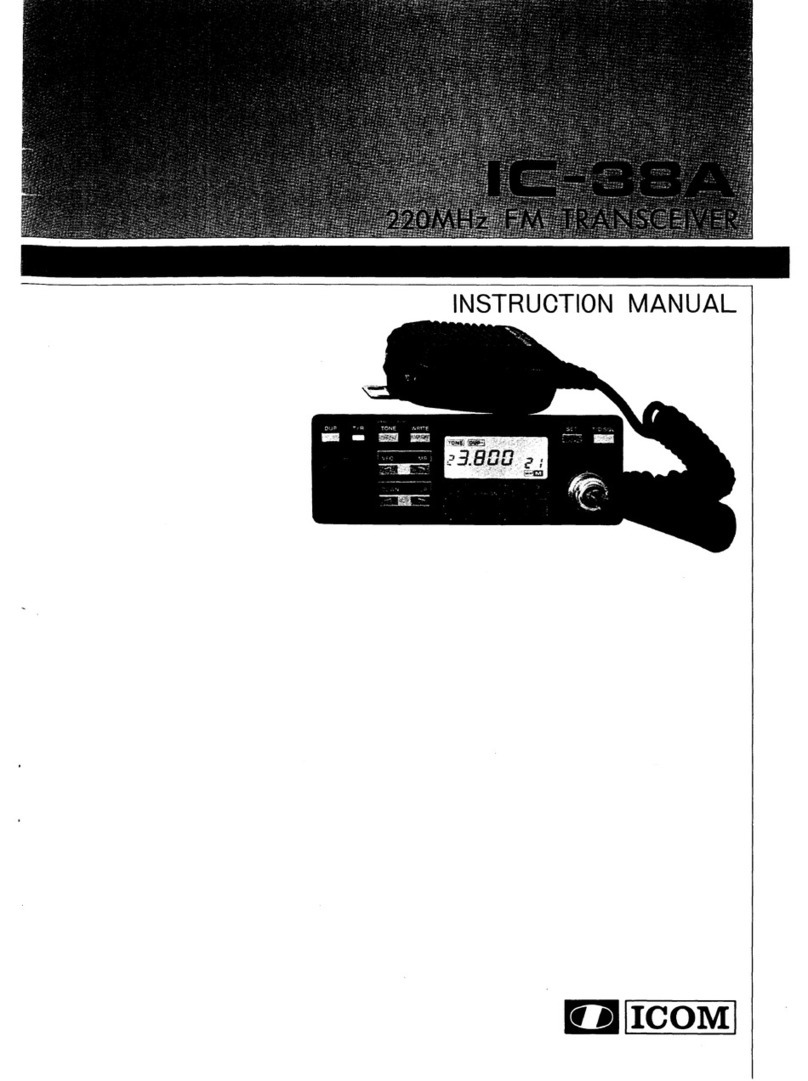
Icom
Icom IC-38A VHF FM User manual
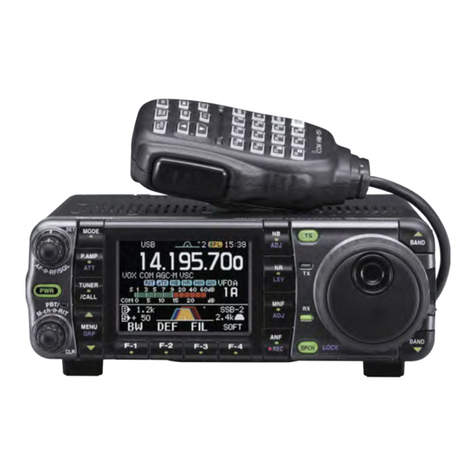
Icom
Icom IC-7000 User manual

Icom
Icom IC-3200A/E User manual
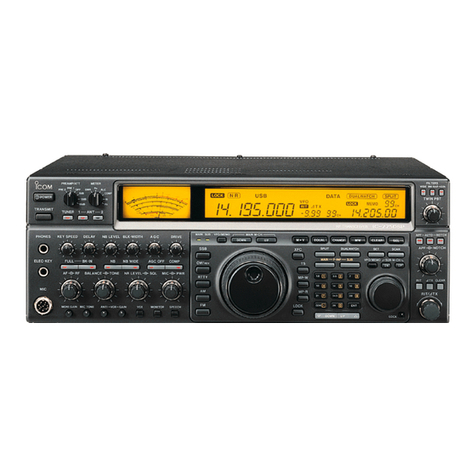
Icom
Icom IC-775DSP User manual
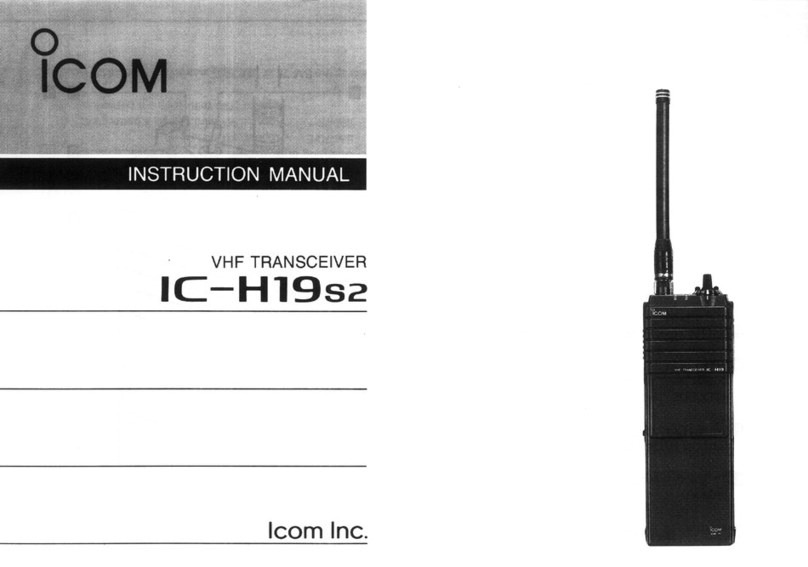
Icom
Icom IC-H19S2 User manual
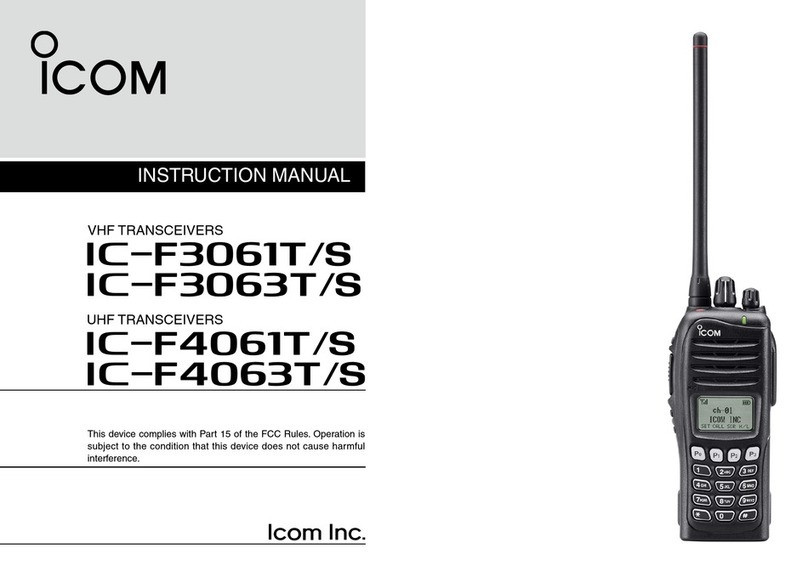
Icom
Icom IC-F3061T User manual
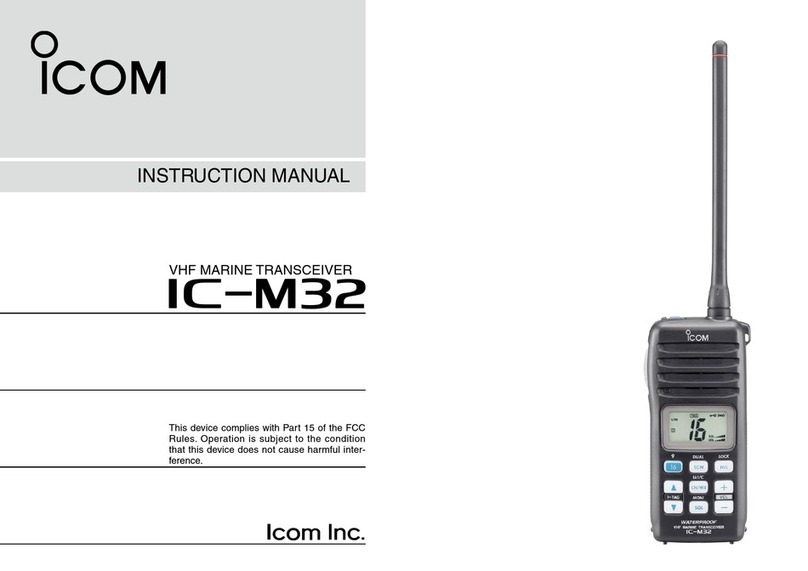
Icom
Icom IC-M32 User manual
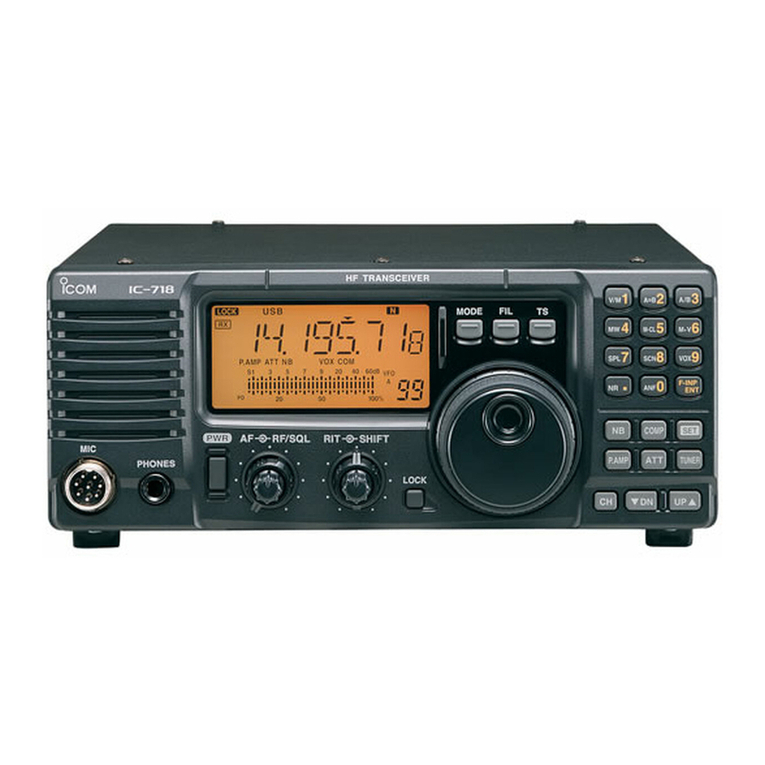
Icom
Icom IC-718 User manual

Icom
Icom IC-9100 Installation guide
